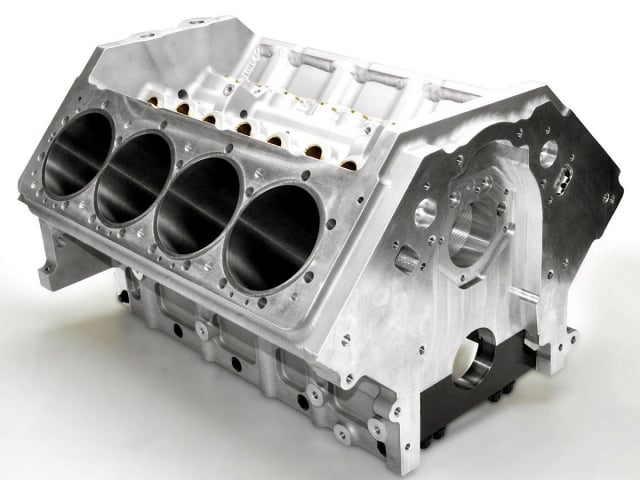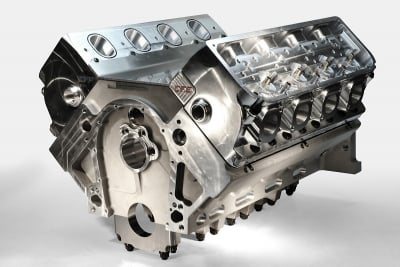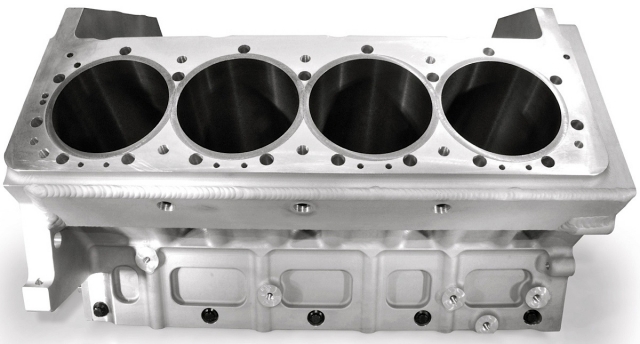 It’s been only a couple years since the aftermarket started developing hybrid cylinder blocks that marry advanced design features of the Gen III and IV LS engines with traditional basics from the original small-block Chevy.
It’s been only a couple years since the aftermarket started developing hybrid cylinder blocks that marry advanced design features of the Gen III and IV LS engines with traditional basics from the original small-block Chevy.
Now, a new “small-block” billet aluminum cylinder block from CFE Racing Products goes one step further and adds high-end racing elements from the Pro Stock DRCE3 platform to that cross-bred concept. The result is a pure racing product called the LS Fusion that boasts incredible power and rpm potential.
“It is a small-block,” CFE’s Larry Gadette tells EngineLabs. “But 33 percent is LS, and 33 percent is traditional small-block and 33 percent is big-block Pro Stock.”
The first of these new blocks was shipped to Hutter Performance in northern Ohio and will be built with a set of custom CFE SBX cylinder heads. In the initial consultation with CFE, Hutter wanted a “small-block” platform that would displace in the area of 430 to 440 cubic inches. The parties discussed the various benefits both the LS and Gen I Chevy engines, but agreed that 4.5-inch bore spacing was critical (both the LS and first-gen Chevy sport 4.4-inch bore spacing).
“We can engineer and make most anything, so they asked if we could put in nine cam bearings, like the DRCE 3 engine,” remembers Gadette. “By the time we got done, what we have isn’t really like anything out there.”
The key LS features are the deep-skirt design to support 6-bolt, cross-bolt mains and a center thrust bearing.
“The crankshaft will be very similar to an LS design,” says Gadette. “For all practical purposes, order an LS crank with 4.5-inch bore spacing.”
The front and rear plate and bolt-patterns are identical to an LS. Even an LS water pump will fit. The oil system was completely redesigned, however, so a factory style LS pump won’t fit. Instead, the LS Fusion block is designed solely for a dry-sump system.
“We took off the clumsy LS oil system (front pump, rear pickup) and also redid the oil galley design,” adds Gadette. “It’s a true main-priority system, similar to a Pro Stock block.”
The block — which is machined from 6061-T6 aluminum billet — is available with or without coolant passages. Drawing from the Gen I style, it sports a 5-bolt-per-cylinder pattern or 19 total head bolts.
Not a big cubic-inch motor
“It may not seem like the LS thing to do, but if you’re spinning to 11,000 rpm, running a pair of turbos or spraying nitrous, those four bolts aren’t enough,” explains Gadette. “Overall the block ended up getting superior head-bolt pattern and far superior cam support.”
The block will support up to a 60mm cam core and features nine cam bearings inside a fully enclosed cam tunnel that is .705-inch higher than a stock LS location.
“It’s probably overkill to some people,” adds Gadette, “but you’ll need it if you run a lot of spring pressure.”
The front and rear of the block closely resembles the LS with similar bolt bolt patterns. The LS Fusion block also utilizes nine cam bearings to help counter high spring pressures required with high-lift lobe profiles.
CFE engineered the block to accept 4.5-inch bore-space symmetrical-port heads similar to the GM splayed-valve heads or CFE’s SBX heads that were originally developed for Pro Stock Trucks in the ’90s. The valvetrain geometry is also dedicated to those heads, including .937-inch keyway lifter bushings. A quick check of the lifter valley shows a very clean, open design with none of the familiar LS trappings such as the supports for plastic lifter buckets.

CFE also engineered a 600ci “small-block” with 4.6-inch bore centers. It more similar to a traditional SBC with the familiar horse-collar timing cover pattern.
The LS Fusion blocks accept starter mounting from either side and can be machined with a deck height up to 10.200-inch.
“This is not an all-out cubic-inch block,” says Gadette. “Somewhere around 457 cubic inches is the end of this particular setup. The reason is the enclosed cam tunnel. For someone looking for 500 to 600 cubic inches, we could make the same design it wouldn’t have the enclosed cam tunnel or nine cam bearings.”
CFE suggests a maximum stroke of 4.200-inch.
“You could put a 4.350-inch bore, and with a 4.100-inch stroke you’ve got a legitimate 11,500-rpm spinner,” says Gadette. “This is a race engine.”
Just like the 600ci small-block with the 4.600-inch bore centers earlier profiled on EngineLabs, this new block was engineered by CFE using a combination of computer design and years of the experience in racing.
“It’s a lot of SolidWorks and math,” sums up Gadette. “But it’s also a lot of knowing what you can and can’t do, no matter what SolidWorks tells you.”





















